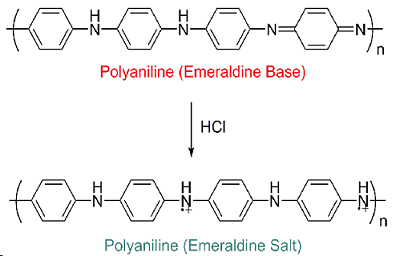Background and overview[1]
Polyaniline is a type of conductive polymer material obtained from aniline monomer through chemical oxidation polymerization or electrochemical polymerization. In 1985, it was discovered that polyaniline film electrodeposited on stainless steel can significantly reduce the corrosion rate of stainless steel in sulfuric acid solution. Since then, polyaniline and other conductive polymers have begun to attract people’s attention as a new type of anti-corrosion material and have gradually become A major hot spot in current research in the field of corrosion science.

At present, polyaniline has excellent anti-corrosion properties, which has been confirmed by a large number of experimental phenomena. Polyaniline anti-corrosion coatings have been partially commercialized in countries such as Germany, the United States, and China. Although there is no unified understanding of the anti-corrosion mechanism of polyaniline, polyaniline coatings have the advantages of being light in weight, and have a certain degree of resistance to pitting and scratching, and are compatible with conventional corrosion inhibitors such as molybdate, Compared with chromate, etc., polyaniline has no environmental pollution and is a green anti-corrosion material with abundant sources. It is expected to become a new generation of anti-corrosion material with great application prospects.
Anti-corrosion mechanism[1-2]
Polyaniline can be divided into two forms: intrinsic state and doped state. Intrinsic state polyaniline can be regarded as a copolymer of p-phenylenediamine units and quinonediimine units. The benzene and quinone content can be used The oxidation or reduction mode changes, but the structures that can exist stably include fully reduced polyaniline (LEB), intermediate oxidized polyaniline (EB), and fully oxidized polyaniline (PNG). The intermediate oxidation state of polyaniline has y=0.5, that is, the repeating unit is composed of 3 benzene rings and 1 quinone ring. It is the most common intrinsic form of polyaniline.
Intrinsic polyaniline can be doped chemically or electrochemically to obtain doped polyaniline. This doped polyaniline can have different conductivities with different doping rates, and can be prepared by alkali or electrochemical doping. Counter-doping is carried out electrochemically, and this doping-counter-doping is reversible. Transitions between various redox states of polyaniline. In the above-mentioned oxidation state transitions, the redox potential of polyaniline is 0.15~0.2V/SCE and 0.6~0.7V/SCE, while the redox potential of metals is generally Negative value, so the redox potential of polyaniline is much higher than that of metal, which is one of the reasons why polyaniline has metal anti-corrosion ability.
Apply[1]
Because polyaniline is expensive, it is usually not used alone, but in combination with matrix resin. Many foreign companies have carried out research and development of polyaniline anticorrosive coatings. As people pay more and more attention to environmental issues, polyaniline coatings are also developing in a more environmentally friendly direction.
Based on long-term accumulation in the field of polyaniline, the Changchun Institute of Applied Chemistry of the Chinese Academy of Sciences has developed two polyaniline anti-corrosion coating systems, namely doped polyaniline/polyurethane system and intrinsic polyaniline/epoxy resin system. , in 2005, assisted Hunan Zhongke Intrinsically Safe New Materials Co., Ltd. in formulating the standards of the Ministry of Communications. The construction performance of these two coatings and the mechanical and physical properties of the paint film have reached practical requirements, and have been promoted and used in heavy machinery, railways, bridges and port projects. It is worth pointing out that during the experiment on offshore hanging panels with anti-corrosion coatings, they discovered that conductive polyaniline has the ability to prevent the attachment of marine organisms. In addition, Jing Xinli and others from Xi’an Jiaotong University also conducted research on polyaniline anticorrosive coatings. Recently, through continuous formula improvement, the Changchun Institute of Chemical Engineering, Chinese Academy of Sciences has made important progress in the anti-corrosion effect of polyaniline coatings. The 80-micron-thick polyaniline epoxy resin primer has a polyaniline content of less than 5% (mass fraction). ), the neutral salt spray test of the crossed sample can still reach 800h, which is equivalent to the level of 80% (mass fraction) zinc-rich primer. Since the density of the polyaniline coating is very low, the coating cost per unit area is Aspects are already highly competitive with zinc-rich primers.
Preparation[3]
Currently, polyaniline preparation methods can be divided into chemical polymerization and electrochemical polymerization.
1. Chemical polymerization method
Chemical polymerization method refers to the method of oxidative polymerization of aniline using appropriate oxidants under appropriate conditions. Including solution polymerization, emulsion polymerization, reverse microemulsion polymerization, template polymerization, etc. The most widely used method is inverse microemulsion polymerization.
1) Inverse microemulsion polymerization method
The reverse phase microemulsion polymerization method is considered to be one of the most ideal synthesis methods for polyaniline nanoparticles. It uses non-polar solvents as the continuous phase and uses oil-soluble emulsifiers to make aniline monomers The aqueous solution is dispersed into a water-in-oil (W/O) emulsion for polymerization. The polyaniline product obtained by this method has small particle size, improved conductivity, yield and solubility. Using benzoyl peroxide as the initiator, dodecylbenzene sulfonic acid as the emulsifier, 2-propanol as the solvent, and doping polyvinyl alcohol, a polyaniline/polyvinyl alcohol composite was prepared by inverse microemulsion polymerization. Material. Using aniline monomer as raw material, poly(3,4-ethylenedioxythiophene) (PEDOT)-doped polyaniline was prepared by inverse microemulsion polymerization in hydrochloric acid solution to obtain polyaniline/ PEDOT nanofibers. Using sodium dodecyl benzene sulfonate (SDS) as the emulsifier, cyclohexane as the solvent, H2O2 as the oxidant, and potassium persulfate (KPS) as the initiator, in acidic conditionsUnder these conditions, aqueous aniline solution purified by vacuum distillation was added, and high-quality polyaniline was synthesized by inverse microemulsion polymerization.
Main reference materials
[1] Polyaniline – a new generation of environmentally friendly anti-corrosion materials
[2] Progress in synthesis and mechanism research of polyaniline
[3] Research and application status of polyaniline in anti-corrosion

 微信扫一扫打赏
微信扫一扫打赏

